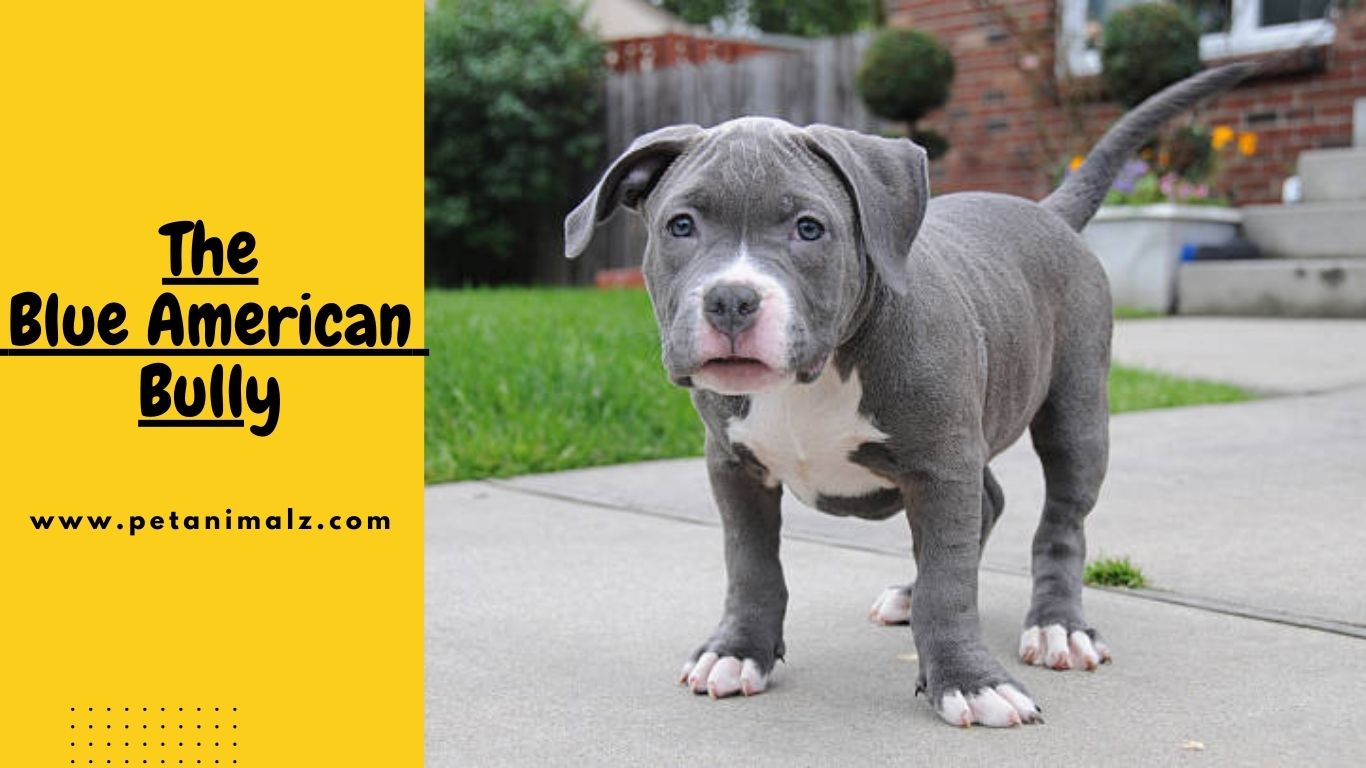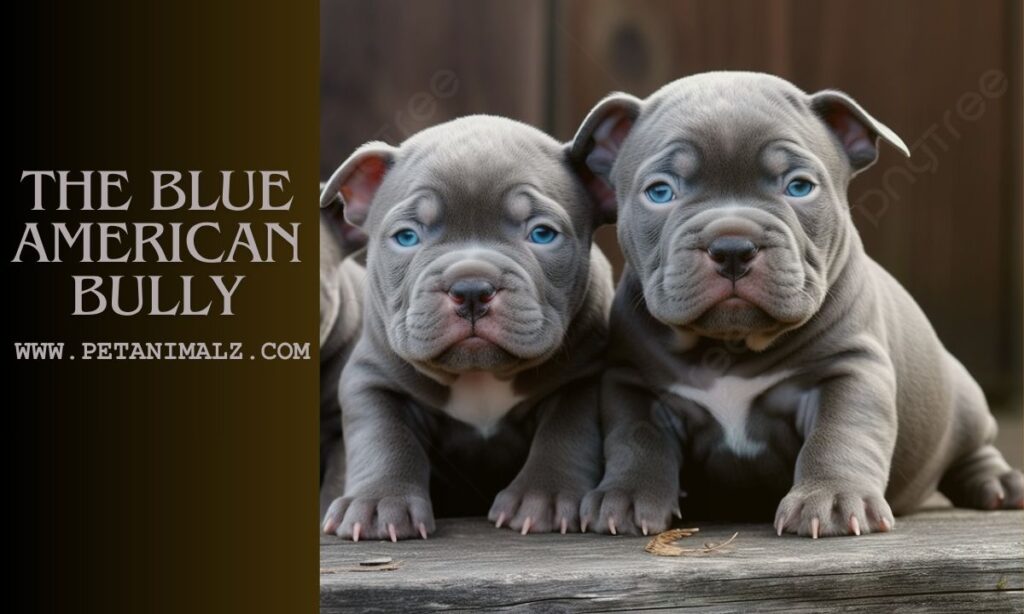The Blue American Bully: A Comprehensive Guide
Introduction
This article provides complete information regarding blue American bully. The Blue American Bully is not just another dog breed; it’s a testament to canine beauty and strength. With its unique color and striking characteristics, this breed stands out in any crowd. This article aims to be more comprehensive than any other source out there, diving deep into the world of the Blue American Bully.

History and Origin of the Blue American Bully
- Established in the mid-1990s, the Blue American Bully has a relatively young history.
- The primary purpose behind its creation was to have the ultimate family companion.
- Its roots can be traced back to both the East and West Coasts of the U.S.
- While often confused with the American Pitbull Terrier, the Blue American Bully boasts distinct features and lineage.
Physical Characteristics
The Blue American Bully is a sight to behold:
- Coat: Short, glossy, and stiff to the touch.
- Head: Medium length with a broad skull and very pronounced cheek muscles.
- Ears: Can be cropped or uncropped, but always high set.
- Eyes: Round to oval, set far apart, with all colors being acceptable except albinism.
- Muzzle: Medium length, rounded on the upper side.
- When it comes to size:
- Height: Ranges between 13 – 21 inches.
- Weight: Varies from 70 – 120 pounds.
- The term ‘blue-nose‘ specifically refers to the color of the dog, making it unique.
- The breed has various categories, including:
- Standard
- XL
- Extreme
- Classic
Temperament and Behavior
The Blue American Bully is more than just its looks:
- At its core, the breed is happy, outgoing, and incredibly stable.
- Known for its loyalty, it’s a breed that will stand by its owner through thick and thin.
- Its intelligence is evident in its behavior, and it has strong protective instincts.
- Socialization is crucial for this breed, especially when young. Proper training can curb any aggressive tendencies.
- Their relationship with children is noteworthy. They’re known for their extreme tolerance, making them perfect family pets.
Genetics and Breeding:
Breeding dogs is a complex process that requires a deep understanding of genetics to produce healthy and desirable offspring. This is especially true for specific breeds, where certain traits are sought after. Here’s a detailed look into the world of genetics and breeding:
1.Basics of Genetics
- DNA: The blueprint of life. It contains genes, which are segments of DNA that determine specific traits.
- Chromosomes: Structures in cells that house the DNA. Dogs have 78 chromosomes, arranged in 39 pairs.
- Alleles: Variations of a gene. For every trait, a dog inherits two alleles (one from each parent).
- Dominant and Recessive Genes: Dominant genes mask the effect of recessive genes. For a recessive trait to show, the dog must inherit two copies of the recessive allele.
2. Breeding Objectives
- Health: Breeding should prioritize the health of the offspring. This includes screening for hereditary conditions and avoiding breeding dogs with known health issues.
- Temperament: A dog’s behavior and temperament are partly genetic. Breeding should aim for stable and desired temperaments.
- Physical Traits: Breeders may aim for specific physical traits, like coat color or size, based on breed standards.
- Breeding Methods
- Line Breeding: Breeding dogs that are related, like grandfather to granddaughter. This can solidify specific traits but increases the risk of hereditary diseases.
- Outcrossing: Breeding unrelated dogs of the same breed. This increases genetic diversity.
- Crossbreeding: Breeding dogs of different breeds. This can be done to combine desirable traits or create new breeds.
4. Genetic Testing
- Purpose: To identify carriers of specific genetic disorders and make informed breeding decisions.
- Benefits: Helps in reducing the prevalence of hereditary diseases in offspring.
5. Ethical Considerations
- Overbreeding: Breeding a dog too often can lead to health issues.
- Puppy Mills: Commercial breeding facilities that prioritize profit over the well-being of the dogs.
- Inbreeding: Breeding closely related dogs can lead to a higher risk of hereditary diseases.
6. Importance of Pedigree
- Pedigree Analysis: Helps breeders understand the lineage of a dog and make informed breeding decisions.
- Registration: Authenticates a dog’s lineage and ensures it meets the breed standard.

Is The Blue American Bully And The Pitbull The Same?
The terms “Blue American Bully” and “Pitbull” are often used interchangeably by the general public, leading to confusion. However, they are distinct breeds with different histories, physical characteristics, and temperaments. Let’s delve into the differences and similarities between the two:
Historical Background
- Blue American Bully: This breed was established in the 1980s and 1990s in the U.S. It was developed by crossing the American Pit Bull Terrier with other dog breeds, including the American Staffordshire Terrier and sometimes the English Bulldog, to achieve specific physical and temperamental traits.
- Pitbull (American Pit Bull Terrier): The American Pit Bull Terrier has a longer history, tracing back to the early 19th century in the UK. It was initially bred for bull-baiting and later for dog fighting.
Physical Characteristics
- Blue American Bully: Generally, they have a more muscular and stocky build. Their heads are broader, and they have shorter muzzles. The term “blue” refers to their specific coat color, which is a result of a genetic trait.
- Pitbull: They have a leaner and more athletic build. Their heads are proportionate to their bodies, and they have a longer muzzle.
Temperament
- Blue American Bully: Known for their calm and friendly nature, they are often described as great family companions. They are less aggressive compared to their ancestors and are more suited for a family environment.
- Pitbull: While they can be loving and loyal, they have a more protective nature. With proper training and socialization, they can be great pets, but they often require a more experienced handler due to their strong prey drive.
Breed Recognition
- Blue American Bully: Recognized as a separate breed by certain kennel clubs, including the United Kennel Club (UKC) and the American Bully Kennel Club (ABKC).
- Pitbull: The term “Pitbull” is often a catch-all for several breeds, but the American Pit Bull Terrier is recognized by the UKC. However, the American Kennel Club (AKC) recognizes the American Staffordshire Terrier, which is closely related but considered a separate breed.
What Is The Blue American Bully Coat Like?
The Blue American Bully is renowned for its distinctive coat, which is one of the breed’s standout features. Let’s delve into the specifics of the Blue American Bully’s coat:
1. Color
- Blue Hue: The term “blue” in the Blue American Bully doesn’t refer to a true blue but rather a diluted black that gives a grayish or silver-blue appearance. This coloration is due to a specific genetic trait.
- Variations: Within the blue spectrum, there can be variations ranging from deep slate to a lighter gray. Some Blue American Bullies may also have white markings or patches.
2. Texture and Length
- Short and Smooth: The Blue American Bully boasts a coat that is short, lying close to the body. It has a smooth texture that is glossy to the touch.
- Consistency: The coat is consistent throughout the body, without any long patches or fringes.
3. Maintenance
- Low Shedding: One of the advantages of the Blue American Bully’s coat is that it’s a low-shedding breed. This makes them relatively easier to groom compared to high-shedding breeds.
- Regular Grooming: Despite being low-shedding, regular grooming is recommended. A weekly brush will help remove loose hairs and keep the coat looking its best. It also promotes skin health by distributing natural oils.
- Bathing: Bathing can be done as needed, but it’s essential not to over-bathe as this can strip the coat of its natural oils.
4. Skin Considerations
- Sensitive Skin: The Blue American Bully, like other bully breeds, can have sensitive skin. The blue coat, in particular, can sometimes be associated with skin issues.
- Regular Check-ups: It’s essential to regularly check for signs of skin infections, allergies, or irritations. Prompt treatment can prevent minor issues from becoming severe.
What Other Expenses Are There For Blue American Bullies?
Owning a Blue American Bully, like any dog, comes with various expenses beyond the initial purchase or adoption fee. Here’s a breakdown of potential costs you might incur:
1. Food and Nutrition
- High-Quality Dog Food: Given their muscular build, Blue American Bullies require nutrient-rich food. This can be more expensive than regular dog food.
- Supplements: Depending on their health needs, you might need to invest in supplements like joint support or vitamins.
2. Health Care
- Regular Vet Check-ups: Routine check-ups are essential to monitor their health.
- Vaccinations: Essential for preventing various diseases.
- Emergency Care: Accidents or sudden illnesses can lead to unexpected vet bills.
- Medications: This includes heartworm prevention, flea/tick treatments, and any other required medicines.
- Pet Insurance: To offset some of the potential medical expenses, many owners opt for pet insurance.
3. Grooming
- Professional Grooming: While they have a short coat, occasional professional grooming can be beneficial.
- Grooming Supplies: Brushes, nail clippers, shampoos, and other grooming essentials.
4. Training and Socialization
- Professional Training: Especially for first-time owners, professional training sessions can be beneficial.
- Obedience Classes: Helpful for socialization and basic commands.
5. Accessories and Supplies
- Bedding: Comfortable beds or crates for them to rest.
- Toys: To keep them entertained and mentally stimulated.
- Leashes and Collars: Essential for walks and identification.
- Identification Tags and Microchipping: For safety and identification purposes.
6. Boarding and Daycare
- Boarding: If you travel, you might need to board your Bully.
- Daycare: If you work long hours, a daycare can provide your dog with socialization and activity.
7. Miscellaneous Expenses
- Licensing: Many municipalities require annual licensing for dogs.
- Travel Expenses: If you travel with your dog, you might incur additional fees.
- Treats and Snacks: For training and spoiling your pet.
Caring for a Blue American Bully
Health Considerations
When it comes to the Blue American Bully, health is paramount:
- Common Health Issues: Like all breeds, they have their set of health concerns. Regular vet check-ups and being aware of symptoms can prevent many of these.
- Steroids: It’s tempting to give steroids for a muscular appearance, but it’s dangerous. Steroids can lead to organ and joint problems.
- Life Expectancy: Typically, they live for about 8-12 years. Proper care, diet, and exercise can ensure they live a healthy and long life.
Living Conditions and Exercise
A happy Bully is an active one:
- Apartment Living: They can adapt to apartment living, provided they get their daily dose of exercise.
- Exercise Needs: Regular walks and mental stimulation are crucial. Playtime and training sessions can keep them engaged.
- Climate: They prefer warmer climates but can adapt as long as they have a cozy spot indoors.
Diet and Nutrition
Feeding your Bully right is essential:
- Recommended Diet: High-quality dog food, rich in protein and essential nutrients.
- Foods to Avoid: Chocolate, grapes, onions, and other toxic foods for dogs.
- Hydration: Ensure they have access to fresh water at all times. It’s vital for their health.
FAQs
Some common questions about the Blue American Bully:
Is the Blue American Bully aggressive?
With proper socialization and training, they are gentle and friendly.
How often should I feed my Bully?
Twice a day is standard, but always consult with your vet.
Are they good with kids?
Absolutely! They’re known as the family companion for a reason.
What can’t American Bully eat?
Chocolate: Highly toxic to most dogs, including the American Bully.
Grapes and Raisins: Can cause kidney failure.
Onions and Garlic: Can lead to anemia.
Xylitol: Found in many sugar-free products, it can cause rapid insulin release leading to hypoglycemia.
Alcohol: Can cause intoxication, coma, or death.
Caffeine: Products like coffee or tea can be toxic.
Bones: Especially cooked bones, can splinter and cause blockages or tears in the digestive system.
Avocado: Contains a substance called persin which can be harmful.
How much should an American Bully eat?
The amount varies based on the dog’s age, weight, activity level, and metabolism. On average, an adult American Bully may eat 2-3 cups of high-quality dry dog food daily, divided into two meals. Always consult with your vet for specific recommendations.
What can I feed my Bully to gain weight?
High-quality dog food: Ensure it’s rich in protein and fat.
Lean meats: Such as chicken, beef, or turkey.
Fish: Like salmon, which is rich in omega-3 fatty acids.
Peanut butter: A good source of protein and healthy fats.
Eggs: Can be given boiled or raw (if you’re sure they’re free from bacteria).
Quinoa: A protein-rich grain.
Vegetables: Such as sweet potatoes and peas.
Is egg good for American Bully?
Yes, eggs are a great source of protein and can be beneficial for American Bullies. They can be served boiled, scrambled, or even raw (ensure they’re fresh and free from bacteria).
Can a Bully eat rice?
Yes, rice is a good source of carbohydrates and is easy to digest. It’s especially useful if your Bully has an upset stomach. Brown rice offers more nutritional value than white rice.
Can my Bully drink milk?
Some American Bullies can tolerate milk, while others may be lactose intolerant. If your Bully hasn’t had milk before, introduce it slowly and in small amounts to see how they react. If they show signs of digestive upset, it’s best to avoid milk.
Can American Bully eat raw egg?
Yes, raw eggs can be given to American Bullies, but ensure they’re fresh to avoid the risk of bacterial infections like salmonella. Some owners also give the shell, crushed, as a calcium supplement.
Conclusion
The Blue American Bully is truly a unique breed, combining strength with a gentle nature. If you’re considering getting one, dive deep into research and ensure you’re ready for the commitment. They’re not just pets; they’re family.




